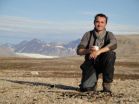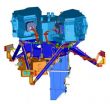(Press-News.org) An analysis of geological records that preserve details of the last known period of global warming has revealed 'startling' results which suggest current targets for limiting climate change are unsafe.
The study by climate change experts at the University of Exeter has important implications for international negotiators aiming to agree binding targets for future greenhouse gas emission targets.
Professor Chris Turney and Dr Richard Jones, both from the University's Department of Geography, have reported a comprehensive study of the Last Interglacial, a period of warming some 125,000 years ago, in the latest issue of the Journal of Quaternary Science.
The results reveal the European Union target of limiting global temperature rise to less than 2°C above pre-industrial levels shouldn't be considered 'safe'.
From their analysis, the scientists found 263 estimates of the conditions when sediments and ice were laid down during the Last Interglacial, allowing them to reconstruct past temperatures around the globe. To compare the reconstructed estimates with today, they took the Last Interglacial values away from modern temperatures averaged over the period 1961 to 1990.
The results show temperatures appear to have been more than 5˚C warmer in polar regions while the tropics only warmed marginally; strikingly similar to recent trends. Not only this, but taken together, the world appears to have been some 1.9˚C warmer when compared to preindustrial temperatures. Critically, the warmer temperatures appear to have resulted in global sea levels some 6.6 to 9.4 metres higher than today, with a rate of rise of between 60 to 90 centimetres per decade — more than double that recently observed.
The higher temperatures seen during the Last Interglacial are comparable to projections for the end of this century under the low emission scenarios contained within the recent Fourth Assessment Report of the Intergovernmental Panel on Climate Change (IPCC).
Professor Turney said: "The results here are quite startling and, importantly, they suggest sea levels will rise significantly higher than anticipated and that stabilizing global average temperatures at 2˚C above pre-industrial levels may not be considered a 'safe' target as envisaged by the European Union and others. The inevitable conclusion is emission targets will have to be lowered further still."
INFORMATION:
The full paper, Does the Agulhas Current amplify global temperatures during super-interglacials?, appears in the latest edition of the Journal of Quarternary Science. It can be viewed here: http://onlinelibrary.wiley.com/doi/10.1002/jqs.1423/abstract
Notes for editors:
A blog by Professor Chris Turney on this subject, called A Lesson from Past Global Warming, can be viewed on his website at www.christurney.com
For more information, please contact:
Professor Chris Turney
E-mail: c.turney@exeter.ac.uk
Tel: +44 (0) 7787 512295
Professor Richard Jones
E-mail: R.T.Jones@exeter.ac.uk
Tel: +44 (0) 1392 723348
Daniel Williams
Press Officer
University of Exeter
Tel: 01392 722062
Email: d.d.williams@exeter.ac.uk
Research suggests climate change target 'not safe'
2010-10-02
ELSE PRESS RELEASES FROM THIS DATE:
Ocean conditions likely to reduce Colorado River flows during this winter's drought
2010-10-02
The convergence in the coming year of three cyclical conditions affecting ocean temperatures and weather is likely to create unprecedented challenges for states that depend on water from the Colorado River, a new UCLA study suggests.
"If I were concocting a recipe for a perfect drought, this would be it," said Glen MacDonald, co-author of the study and director of UCLA's Institute of the Environment and Sustainability.
Along with a former graduate student, MacDonald has found that the combination of La Niña with two less commonly known ocean conditions — the Pacific ...
Growth of biofuel industry hurt by GMO regulations
2010-10-02
CORVALLIS, Ore. – Faster development of the promising field of cellulosic biofuels – the renewable energy produced from grasses and trees – is being significantly hampered by a "deep and thorny regulatory thicket" that makes almost impossible the use of advanced gene modification methods, researchers say.
In a new study published today in the journal BioScience, scientists argue that major regulatory reforms and possibly new laws are needed to allow cellulosic bioenergy to reach its true potential as a form of renewable energy, and in some cases help reduce greenhouse ...
Researchers engineer adult stem cells that do not age
2010-10-02
BUFFALO, N.Y. -- Biomedical researchers at the University at Buffalo have engineered adult stem cells that scientists can grow continuously in culture, a discovery that could speed development of cost-effective treatments for diseases including heart disease, diabetes, immune disorders and neurodegenerative diseases.
UB scientists created the new cell lines – named "MSC Universal" – by genetically altering mesenchymal stem cells, which are found in bone marrow and can differentiate into cell types including bone, cartilage, muscle, fat, and beta-pancreatic islet cells. ...
Mayo Clinic review of ethical decision making with end-of-life care
2010-10-02
ROCHESTER, Minn. -- In a review article published in the October issue of Mayo Clinic Proceedings,(http://www.mayoclinicproceedings.com) Mayo Clinic physicians differentiate the ethical and legal permissibility of withholding or withdrawing life-sustaining treatments and accepted comfort measures, specifically palliative sedation, from that of physician-assisted suicide or euthanasia.
Physician reviewers find that palliative sedation has an important place on the continuum of appropriate palliative care. "At the end of life, patient goals often shift to comfort, and removal ...
Climate change forcing a 'move it or lose it' approach to species conservation?
2010-10-02
What does it take to save a species in the 21st century? The specter of climate change, with predicted losses to biodiversity as high as 35 percent, has some scientists and managers considering taking their conservation strategies on the road.
Managed relocation (MR) is literally the physical relocation of endangered or threatened species of plants and animals, by humans, to new, and foreign geographical climes. It addresses the concern that climate shifts may make many species' historical ranges environmentally inhospitable, and that the rapid speed of change and habitat ...
GOES-13 sees an unholy matrimony: Nicole and low pressure swamp the US East Coast
2010-10-02
In a "marriage" that U.S. east coast residents would object to, the remnants of Tropical Storm Nicole coupled with an upper level low pressure area have dumped record rainfall from the Carolinas to New England on Sept. 30. The GOES-13 Satellite captured that massive "union" of a system as it begins to push off the northeastern U.S. coast today, Oct. 1.
At 1401 UTC (10:01 a.m. EDT) on Oct. 1, the Geostationary Operational Environmental Satellite called GOES-13 captured a visible image of the extensive cloud cover of this coupled system. The GOES image shows the system's ...
NASA's Webb telescope MIRI instrument takes one step closer to space
2010-10-02
A major instrument due to fly aboard NASA's James Webb Space Telescope is getting its first taste of space in the test facilities at the Rutherford Appleton Laboratory (RAL) in the United Kingdom. The Mid-InfraRed Instrument (MIRI) has been designed to contribute to areas of investigation as diverse as the first light in the early Universe and the formation of planets around other stars.
"The start of space simulation testing of the MIRI is the last major engineering activity needed to enable its delivery to NASA. It represents the culmination of 8 years of work by the ...
Computer-aided detection is increasingly being used in screening and diagnostic mammography
2010-10-02
The use of computer-aided detection (CAD) is increasing, in both screening and diagnostic mammography, according to a study in the October issue of the Journal of the American College of Radiology (www.jacr.org). CAD software systems highlight and alert the radiologist of abnormal areas of density, mass or calcification on a digitized mammographic image (of the breast) that may indicate the presence of cancer.
Screening mammography is an X-ray exam of the breast that is used as a screening tool to detect early breast cancer in women experiencing no symptoms. Diagnostic ...
Measuring productivity helps radiology department improve efficiency
2010-10-02
Researchers working in a radiology department at a mid-sized hospital were able to increase productivity and improve efficiency by developing a simple method for measuring general technologist productivity, according to a study in the October issue of the Journal of the American College of Radiology (www.jacr.org).
"Improving productivity and maintaining team spirit are often competing priorities that may be difficult to achieve simultaneously," said C. Daniel Johnson, MD, co-author of the study. "In an era of cost reductions, radiology departments need to be able to ...
October 2010 Geosphere highlights
2010-10-02
Boulder, CO, USA - This month's themed issue, "Advances in 3D imaging and analysis of geomaterials," edited by Guilherme A.R. Gualda, Don R. Baker, and Margherita Polacci, features papers from the 2009 AGU Joint Assembly session "Advances in 3-D Imaging and Analysis of Rocks and Other Earth Materials." Studies include 3-D imaging and analysis techniques for Wild 2 comet material returned from the NASA Stardust mission and the first 3-D X-ray scans of crystals from the Dry Valleys, Antarctica.
Introduction: Advances in 3D imaging and analysis of geomaterials
Guilherme ...



